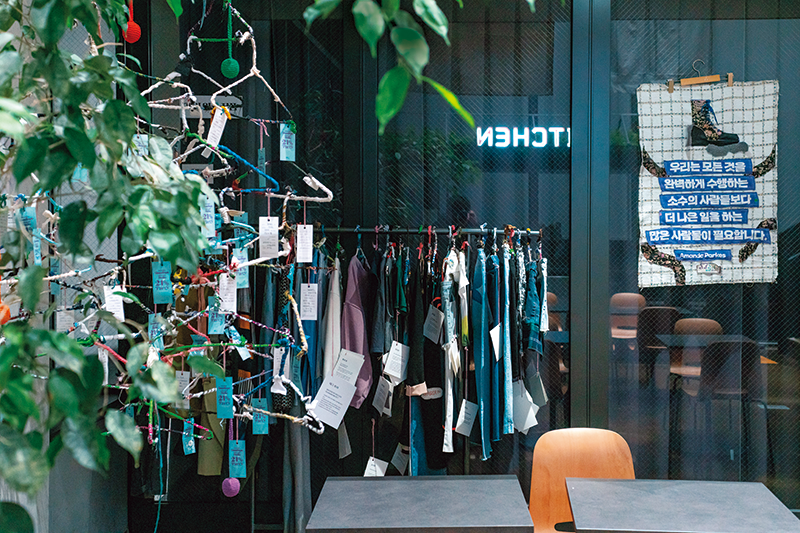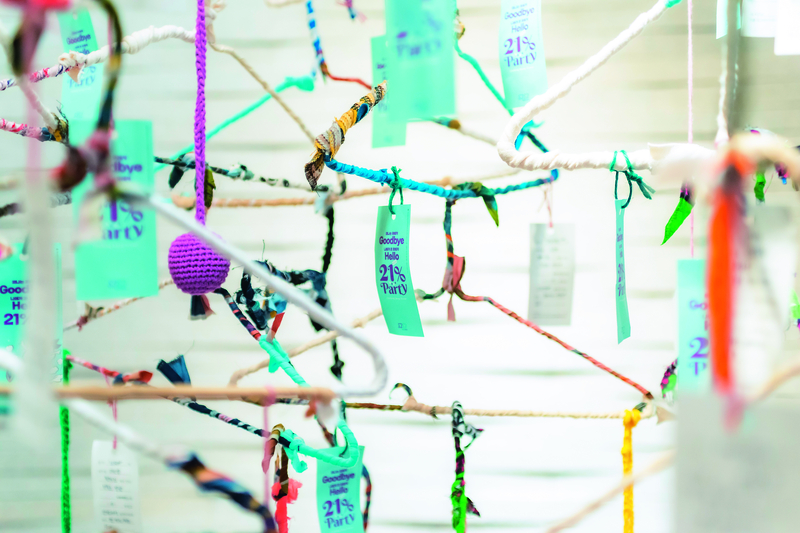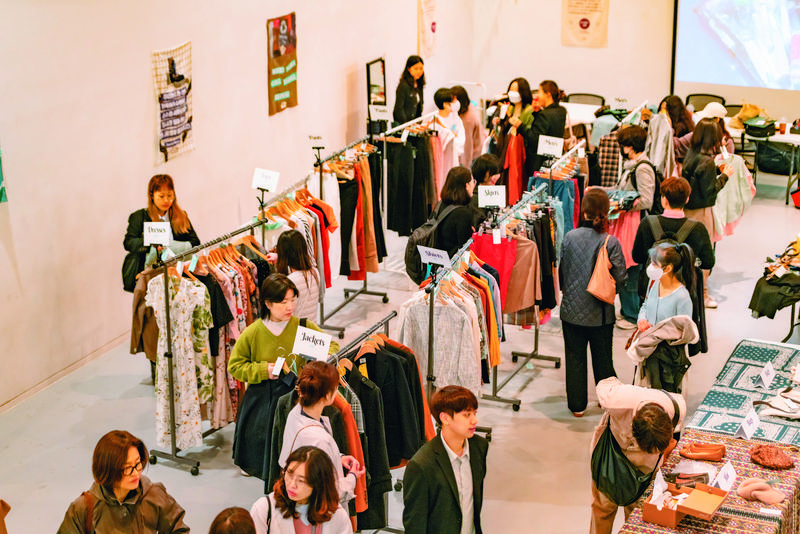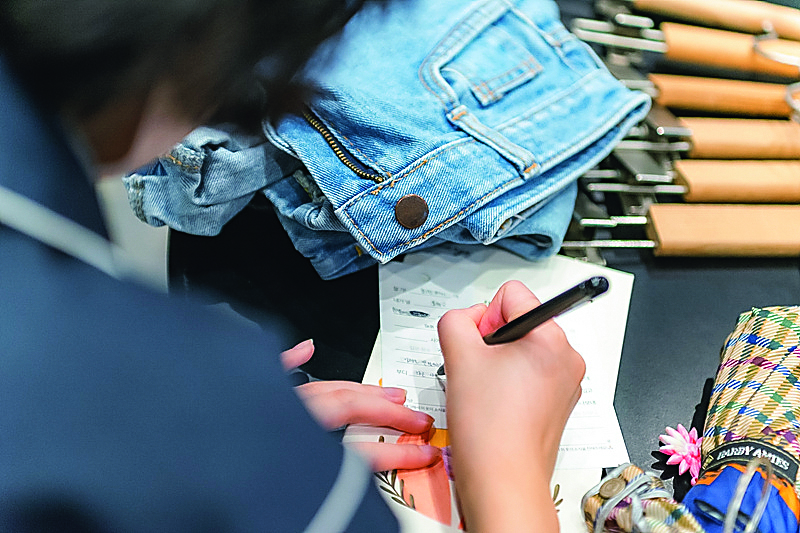The fashion industry, whose virtue is the pursuit of newness, encourages endless production and consumption, both of which have a significant impact on the climate. It is now crucial for everyone to rethink how to maintain a fashion lifestyle that keeps both humans and the Earth healthy.

WearAgain Lab is a nonprofit start-up that seeks to raise awareness about the fashion industry’s harmful impact on the environment and reduce apparel waste.
© WearAgain Lab
Walking dawn shopping streets, one can easily be overwhelmed by the sheer volume of clothes on sale in every store, wondering who buys them all, and when. Established fast fashion brands release ever-new collections week after week, particularly in major cities, in order to drive fashion trends. Every season, new clothes are manufactured on an enormous scale. As a result, our closets may be full of clothes, but at least once every season we still end up asking ourselves, “Why don’t I have anything to wear?”
ENCOURAGING ZERO WASTE FASHION
People who like trying out new outfits but are concerned about the fashion industry’s environmental impact, and who no longer want to be surrounded by clothes that are hardly worn but too good to throw out, should check out WearAgain Lab. The nonprofit zero-waste fashion start-up and research center studies numerous aspects of the fashion industry and practices the value of reuse through wearing things again.
WearAgain Lab’s main activity is sponsoring “21% Parties” where people swap second-hand clothing with the aim of promoting the recirculation of resources. The parties’ name comes from the percentage of an average person’s clothing that ends up unworn and practically abandoned. Participants must bring a share of their own unworn clothes in order to be able to exchange them with those brought by others. A dress someone kept for several years hoping they would lose enough weight to wear it, an accessory that doesn’t match with anything, a pair of shoes bought on impulse that doesn’t go with the rest of the wardrobe, or a piece of clothing that holds vivid memories but is no longer worn. These are the type of items that can be brought to 21% Parties. Instead of a price tag, each piece of clothing has a Goodbye & Hello tag containing a brief note from the owner about the item; this adds an element of fun and entertainment. The process of exchange offered at these parties represents an interesting experiment in which users browse through someone else’s past and the history attached to their clothing.
REUSE RATHER THAN RECYCLING

The Goodbye & Hello tag, which allows users to tell the stories behind the clothing they bring to a 21% Party.
© WearAgain Lab
According to statistics released by the Ministry of Environment in 2021 on the amount of waste produced and processed nationwide, recyclable waste included 118,000 tons of scrap clothing. When including both recyclable scrap fibers and scrap fibers thrown out along with regular household waste, the total figure increased to 412,000 tons. The crux of the issue is that on any given day, too much clothing is being manufactured and discarded throughout the world.
Innovation is required to continue being able to offer newness while helping to reduce the mountains of textile waste. WearAgain Lab emphasizes neither upcycling nor recycling but reuse. While upcycling and recycling don’t involve discarding anything, they still result in the consumption of resources. Furthermore, it is functionally impossible to either recycle or upcycle the enormous amount of clothing in people’s closets worldwide. WearAgain Lab suggests that the way forward is to wear clothing that has already been manufactured for as long as possible, while also discarding as little clothing as possible. The start-up is also devoted to reducing apparel waste by revitalizing the culture of second-hand fashion.
WEARAGAIN LAB'S RESEARCH

21% Parties, WearAgain Lab’s main activity, is both a marketplace where users exchange second-hand clothing and a forum that promotes sustainable fashion culture to consumers accustomed to mainstream fashion. Participants receive the same number of exchange tickets as the items of clothing they bring, which they can use to trade for other garments.
© WearAgain Lab
The merits of second-hand fashion are endless, but the biggest joy is found in coming across a delightful and unexpected piece of clothing. There are certain boundaries that shoppers adhere to, particularly when shopping for fashion. However, second-hand fashion markets lead them to new neighborhoods and encourage them to experiment with new tastes, brands, and styles.
By giving up the obsession with the latest fashion trends, one can also achieve a sense of timelessness. Instead of opting for in-season items that cannot be worn without feeling self-conscious a year or two down the road, people can express their own style using a combination of wit and sense. This is where a boring fashion life becomes enriched. At 21% Parties, where every transaction occurs through the exchange of clothing, one may discover unusual or delightful garments or accessories and try on clothes without qualms, and there is no sense of guilt over the environment.
A special relationship develops when participants see their clothes being tried on by someone else. Everybody shares and exchanges their clothing, and little by little, a worrisome future turns into a hopeful one. That said, the areas researched by WearAgain Lab are largely neglected by the wider fashion industry.
The environmental start-up doesn’t just pursue an emotional experience. Items of clothing that would otherwise be discarded see their lives extended, and this in itself holds meaning. The longer the lifecycle of a piece of clothing, the less energy generated during its disposal, which means there is no increase in either water usage or carbon emissions. This is a well-known but often forgotten or ignored fact. WearAgain Lab makes this reality undeniable through the presentation of clear figures. In April, a 21% Party was held for ten days, with a total of 831 participants. Eighteen teams participated nationwide, and 2,908 pieces of clothing were collected, of which 2,239 were exchanged. This overall process had the equivalent effect of saving 652,601 liters of water and 17,263 kilograms of carbon. Such significant, specific figures are a wake-up call that illustrate the tangible implications of WearAgain Lab’s research.
MOVEMENT FOR SUSTAINABILITY

A participant writing on a Goodbye & Hello tag. Information about the clothing, such as when the item was purchased and how many times it has been worn, can be written on the tag, along with a farewell message to the clothing and a greeting to the new owner.
© WearAgain Lab
Through its 21% Parties, WearAgain Lab strives to encourage changes in how people consume fashion while also affecting change through policies and systems. The start-up has launched a campaign to pass a law that bans fashion companies from destroying inventories and returned goods. The initiative represents a concrete and influential move that sends a warning to fashion companies that throw away unsold inventory and only care about their brand image.
In 2021, a KBS program looking into environmental issues, titled There Is No Earth for Clothing, surveyed the seven Korean fashion companies with the highest revenues. It revealed that four of them burned unsold stock. One of the seven companies responded that they would not release information about their practice as it was deemed confidential, and another simply refused to respond at all. Only one company said that they did not destroy their unsold clothing. There is irony in the fact that, on the one hand, people express concern for the environment by sharing and re-wearing second-hand clothing, while, on the other hand, companies engage in energy- and labor-wasting activities that harm the environment. In order to eradicate such irrational practices at the policy level, WearAgain Lab embarked on an in-depth study in January of this year, and three months later, they delivered a petition with 1,363 signatures to National Assembly Member Jang Hye-young demanding the adoption of a law called the Act on the Prohibition of Discarding Inventory and Returned Goods.
Everyone is affected by climate issues, regardless of how much attention one pays to fashion or, indeed, how much joy one derives from it. Even though clothing may be advertised as having been manufactured sustainably, it is important to carefully consider whether this so-called sustainability is, in fact, driving the Earth to extinction. Fashion producers and consumers must adopt new methods and habits to enable people to continue enjoying new fashion, but in ways that are truly sustainable and safeguard the environment. Second-hand fashion may indeed provide the solution, because while fashion trends are often short-lived, second-hand fashion itself never goes out of style.
Yoo Da-mi Editor